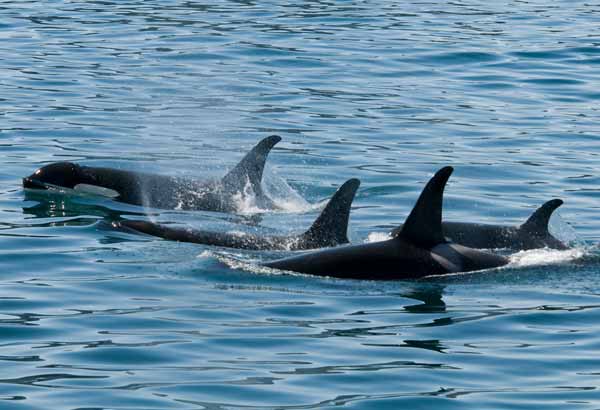Habitat & Distribution
Killer whales inhabit all oceans of the world. Next to humans and perhaps the brown rat (Rattus norvegicus), killer whales are the most widely distributed mammal.
Populations have been documented foraging for long periods of time in shallow coastal and inter-tidal flats in just a few meters of water.

While killer whales can be found around the world, they are much more common in highly productive areas of cold-water upwelling; including the Pacific Northwest, along northern Norway's coast in the Atlantic, and the higher latitudes of the Southern Ocean.
In addition to being found in colder water, killer whales also have been seen in warm water areas such as Florida, Hawaii, Australia, the Galapagos Islands, the Bahamas, and the Gulf of Mexico, and more temperate waters such as New Zealand and South Africa. Such sightings are infrequent, but they do demonstrate the killer whales' ability to venture into tropical waters.
Rarely, killer whales have been seen in fresh water rivers around the world such as the Rhine, the Thames, and the Elbe. One even traveled some 177 km (110 mi.) up the Columbia River in pursuit of fish.

Documented sightings of killer whales indicated in dark blue.
Distribution
Depending on the ecotype, killer whales may exploit a variety of habitats, from shallow coastal areas to deep waters off the continental shelf.
- Killer whales are found in the open ocean, but they seem to be most abundant in coastal waters.
- Killer whales are most abundant in the Pacific Northwest, along northern Norway's coast in the Atlantic and in the higher latitudes of the Southern Ocean.
- In the North Atlantic, type 1 killer whales are found in the waters of the northeast Atlantic and Great Britain, while type 2 killer whales are mainly spotted off the west coast of Ireland and Scotland.

The five forms of Antarctic killer whales have different distributions.
- Type A killer whales are circumpolar and live offshore in ice-free water.
- Type B killer whales inhabit inshore waters of Antarctica and the Antarctic Peninsula; large type B near the pack ice; and small type B in more open waters.
- Type C killer whales inhabit inshore waters and pack ice and are most common in the eastern Antarctic.
- The few sightings of type D killer whales have been in deep, subantarctic waters.
The resident, transient, and offshore killer whales of the eastern North Pacific Ocean have overlapping but different distributions.
- Researchers have identified two distinct communities of resident whales, with different distributions. Whales in both communities tend to stay within about 800 km (500 mi.) of coastline. They tend to follow direct routes when traveling, from headland to headland.
- The northern resident stock occurs from the top half of British Columbia's Vancouver Island north through Alaska.
- The southern resident stock occurs from the lower half of British Columbia's Vancouver Island south through Washington State.
- The transient stock occurs from Alaska's Aleutian Islands to Southern California. Transients may spend twice as much time traveling since their movements often follow the contours of the shoreline. Transient whales have been sighted within a 1,450 km (900 mi.) range.
- Throughout the 1980's, the AT1 transient stock was sighted year-round in Prince Williams Sound. The AT1 group was composed of at least 22 whales, but since the 1989 Exxon Valdez oil spill the group is now believed to be reduced to seven members. The National Marine Fisheries Service has designated AT1 as a "depleted stock" under the Marine Mammal Protection Act.
- Offshore killer whales range from the Bering Sea to Southern California and have been sighted in both open-ocean and coastal habitats.
Eastern Tropical Pacific killer whales are usually sighted offshore and range from Southern California to the Mexican waters of the Pacific and Gulf of California.

Migration
In some areas, seasonal movements of killer whales are influenced by migration of their prey.
- Studies of movement patterns of fish-eating North Atlantic killer whales indicate that populations of these whales follow the movements of herring (Clupea harengus) in Icelandic and Norwegian waters and of mackerel in Scottish waters (North Atlantic Killer Whale ID Project). When the stock of herring in Norwegian waters changed its wintering distribution from inland fjords to offshore, the killer whales also changed their movements in response.
In the North Pacific, resident pods tend to travel within specific, localized ranges while transient groups' ranges are wider and less predictable. Both resident and transient killer whales in the North Pacific do not undertake "migration" in the formal sense of the word.
The movements of resident pods in the Pacific Northwest coincide with the migration of their primary prey, salmon.
Type A killer whales appear to be migratory, entering Antarctic waters during the austral summer.
Type B (Antarctic killer whales) undertake rapid migrations from the Antarctic to subtropical waters off Uruguay and Brazil. These rapid travels may be over 5,800 miles (9,400 km) round trip. This migration may be for the purpose of maintenance, with the animals regenerating skin in warmer waters without the high cost of heat loss.
A tagging study has shown that killer whales in the Canadian Arctic region also undertake long-distance movements, likely to avoid heavy ice formation in the winter months.

Population
Killer whales are difficult to census given their worldwide distribution. However, it's estimated that their global population is at least 50,000.
With the exception of the southern resident community in the eastern North Pacific, killer whales are not listed as endangered or threatened.




